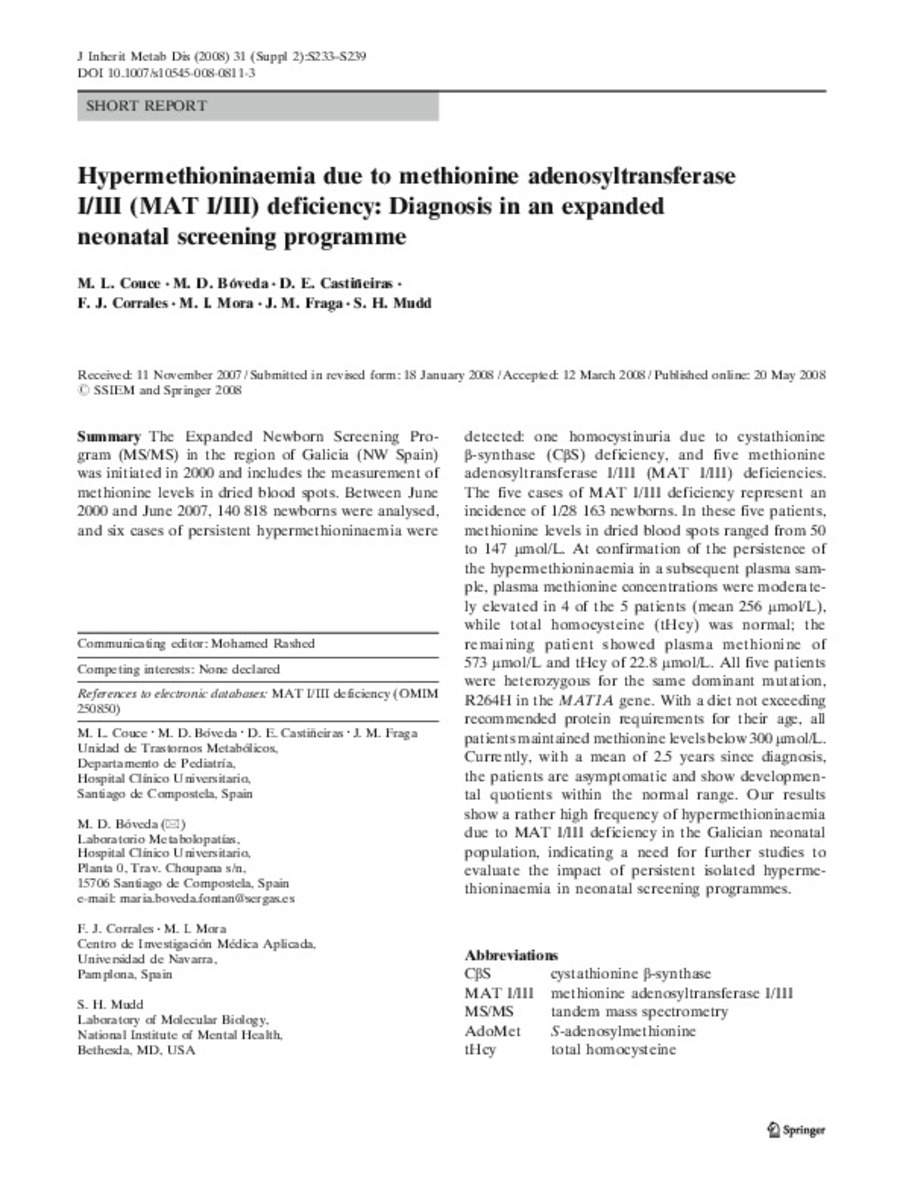Full metadata record
| DC Field | Value | Language |
|---|---|---|
| dc.creator | Couce, M.L. (ML) | - |
| dc.creator | Boveda, M.D. (MD) | - |
| dc.creator | Castiñeiras, D.E. (DE) | - |
| dc.creator | Corrales, F.J. (Fernando José) | - |
| dc.creator | Mora, M.I. (María I.) | - |
| dc.creator | Fraga, J.M. (J. M.) | - |
| dc.creator | Mudd, S.H. (S. Harvey) | - |
| dc.date.accessioned | 2012-03-29T11:28:40Z | - |
| dc.date.available | 2012-03-29T11:28:40Z | - |
| dc.date.issued | 2008 | - |
| dc.identifier.citation | Couce ML, Boveda MD, Castineiras DE, Corrales FJ, Mora MI, Fraga JM, et al. Hypermethioninaemia due to methionine adenosyltransferase I/III (MAT I/III) deficiency: diagnosis in an expanded neonatal screening programme. J Inherit Metab Dis 2008 Dec;31 Suppl 2:S233-9. | es_ES |
| dc.identifier.issn | 1573-2665 | - |
| dc.identifier.uri | https://hdl.handle.net/10171/21395 | - |
| dc.description.abstract | The Expanded Newborn Screening Program (MS/MS) in the region of Galicia (NW Spain) was initiated in 2000 and includes the measurement of methionine levels in dried blood spots. Between June 2000 and June 2007, 140 818 newborns were analysed, and six cases of persistent hypermethioninaemia were detected: one homocystinuria due to cystathionine β-synthase (CβS) deficiency, and five methionine adenosyltransferase I/III (MAT I/III) deficiencies. The five cases of MAT I/III deficiency represent an incidence of 1/28 163 newborns. In these five patients, methionine levels in dried blood spots ranged from 50 to 147 μmol/L. At confirmation of the persistence of the hypermethioninaemia in a subsequent plasma sample, plasma methionine concentrations were moderately elevated in 4 of the 5 patients (mean 256 μmol/L), while total homocysteine (tHcy) was normal; the remaining patient showed plasma methionine of 573 μmol/L and tHcy of 22.8 μmol/L. All five patients were heterozygous for the same dominant mutation, R264H in the MAT1A gene. With a diet not exceeding recommended protein requirements for their age, all patients maintained methionine levels below 300 μmol/L. Currently, with a mean of 2.5 years since diagnosis, the patients are asymptomatic and show developmental quotients within the normal range. Our results show a rather high frequency of hypermethioninaemia due to MAT I/III deficiency in the Galician neonatal population, indicating a need for further studies to evaluate the impact of persistent isolated hypermethioninaemia in neonatal screening programmes. | es_ES |
| dc.language.iso | eng | es_ES |
| dc.publisher | Springer Verlag | es_ES |
| dc.rights | info:eu-repo/semantics/openAccess | es_ES |
| dc.subject | Amino Acid Metabolism, Inborn Errors/diagnosis | es_ES |
| dc.subject | Methionine/blood | es_ES |
| dc.subject | Methionine Adenosyltransferase/deficiency | es_ES |
| dc.subject | Neonatal Screening/methods | es_ES |
| dc.title | Hypermethioninaemia due to methionine adenosyltransferase I/III (MAT I/III) deficiency: diagnosis in an expanded neonatal screening programme | es_ES |
| dc.type | info:eu-repo/semantics/article | es_ES |
| dc.relation.publisherversion | http://www.springerlink.com/content/f81175qk47744615/ | es_ES |
| dc.type.driver | info:eu-repo/semantics/article | es_ES |
Files in This Item:
Statistics and impact
Items in Dadun are protected by copyright, with all rights reserved, unless otherwise indicated.






